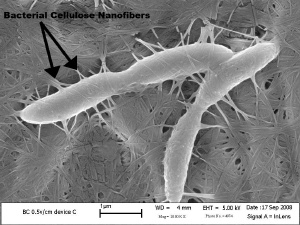Nov 11 2008
Two Virginia Tech engineers have put bacteria to work as tiny weavers of biomaterials and medical implants. Paul Gatenholm and Rafael Davalos, faculty members with the Virginia Tech Wake Forest University School of Biomedical Engineering, have developed a new technology for controlling the motion of bacteria that produce cellulose. The use of bacterial cellulose (BC) for biomaterials has been limited because its mechanical properties cannot be controlled beyond thin, flexible layers. The invention will allow precise control of the tiny weavers so that they can be guided to shapes that will support cartilage and bone tissue growth and other complex biomaterials, according to Gatenholm.
 FESEM images of Acetobacter Xylinum cells embedded in and producing cellulose nanofibers.
FESEM images of Acetobacter Xylinum cells embedded in and producing cellulose nanofibers.
Just as butterflies and spiders produce fibers, so do Acetobacter xylinum bacteria. About five years ago, Gatenholm, then at Chalmers University of Technology in Sweden, wondered if he could control the production of bacterial cellulose and if the material was biocompatible.
He discovered that the bacteria would create fiber layers to fit a template. “The material is much like collagen,” the natural connective tissue produced by the body, he said. He then placed a postage stamp-sized piece of BC material under the skin in a rat and was pleased to see that there was no infection and no rejection. “There was very nice integration,” said Gatenholm.
“Because BC is about 99 percent water, it is soft and flexible,” he said. “The only disadvantage was cells could not pass through because it was not porous. So we placed wax particles on the scaffolds and the bacteria spun around them, then we melted the wax out.”
To address the medical community’s need for small blood vessels, Gatenholm’s team at Chalmers had the bacteria produce tubes. By 2006, the scientists had developed a process for creating tubes of any size or shape. The Swedish government provided funding for scale up and Gatenholm and his colleagues started a company to produce blood vessels. Arterion (http://www.arterion.se/), is now doing animal studies. (Gatenholm has started three companies based on his research at Chalmers University.)
“Now I’m ready to look at what additional good BC can do,” said Gatenholm, who joined Virginia Tech last year as professor of materials science and engineering, affiliate of the Virginia Tech Center for Healing Biomaterials, and an adjunct faculty member with the Wake Forest University Institute for Regenerative Medicine.
One goal is the creation of cartilage –specifically, the creation of scaffolds that would be occupied by chondrocytes – the cells that produce cartilage. “We would build a porous scaffold in the shape of a nose or an ear as a structure for the chondrocytes to move into – in the body, not in a bioreactor. The BC scaffold would be part of the healing process.”
Another large unmet medical need is a way to replace large bone deficits, such as a piece of skull, so people will not have to have metal implants. Gatenholm proposes creating a BC scaffold that incorporates hydroxyapatite, mineral containing calcium and phosphorous that is the basis of bone. “We can create a material that allows the bone healing process to take place – or even stimulates it.”
The needed shapes can be created using BC with the porosity that will allow the natural cells to grow, but the challenge has been the lack of control of mechanical properties – the stiffness required for cartilage and bone scaffolds.
The solution presented itself when Gatenholm met Davalos, assistant professor of engineering science and mechanics, whose research includes cell mechanics, microfluidics, and the use of an electric current to create temporary pores in the cell wall and permanent pores that will result in cell death. In the process of this research, Davalos discovered that he could control bacteria motion using electrical fields.
In work work is supported by the Virginia Tech Institute for Critical Technology and Applied Science, Gatenholm and Davalos applied this control ability to the cellulose producing bacteria and soon had them shuttling back and forth, like a nanoscale loom, assembling cellulose layers into custom three-dimensional architectures. “Now we can engineer the needed mechanical properties to support micro-scale fluid flow and the environment for the target cells – chondrocytes, for instance – to attach and grow. The nanofibril alignment such as in natural collagen tissue will greatly improve the strength and stiffness of scaffolds,” said Gatenholm.
Virginia Tech Intellectual Properties Inc. (www.vtip.org) has applied for a patent for Gatenholm and Davalos’ “dielectrophorectic microweaving” technology, which will be introduced at the Mid-Atlantic Innovation Showcase on Friday, Nov. 14, at the Hilton McLean Tysons Corner.
A new company, BCGenesis (www.bcgenesis.org/) has been established in Blacksburg, Va. to provide biocompatible material for healing soft or hard connective tissue, such as bone grafts and cartlilage replacement and other orthopedic applications. Erik Gatenholm of Blacksburg will be the CEO.
Learn more about Paul Gatenholm's research here: http://www.sbes.vt.edu/people/faculty/primary/gatenholm.html